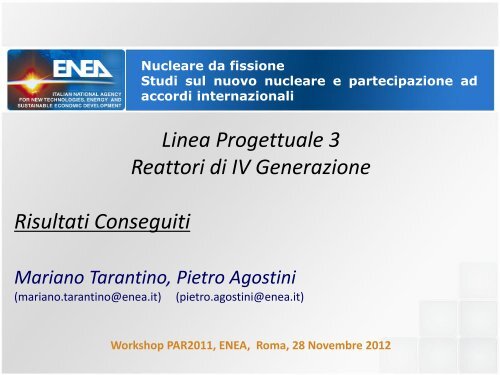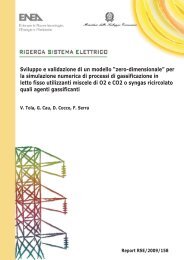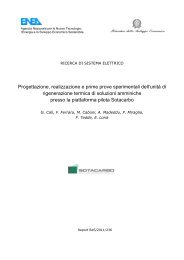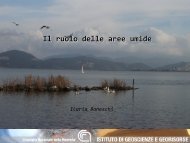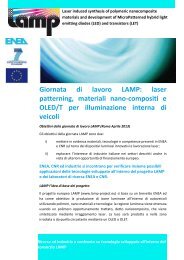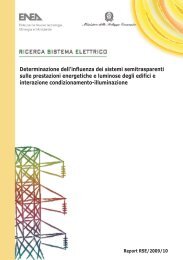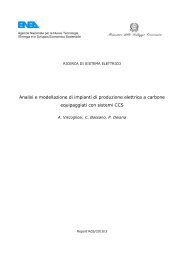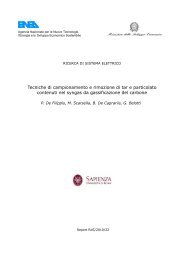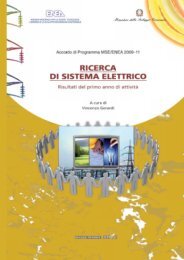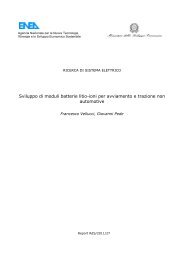LFR Demonstrator (ALFRED) - Enea
LFR Demonstrator (ALFRED) - Enea
LFR Demonstrator (ALFRED) - Enea
You also want an ePaper? Increase the reach of your titles
YUMPU automatically turns print PDFs into web optimized ePapers that Google loves.
Risultati Conseguiti<br />
Nucleare da fissione<br />
Studi sul nuovo nucleare e partecipazione ad<br />
accordi internazionali<br />
Linea Progettuale 3<br />
Reattori di IV Generazione<br />
Mariano Tarantino, Pietro Agostini<br />
(mariano.tarantino@enea.it) (pietro.agostini@enea.it)<br />
Workshop PAR2011, ENEA, Roma, 28 Novembre 2012
Overview<br />
<strong>LFR</strong> Development<br />
International and<br />
national frame<br />
Conceptualization &<br />
System Design<br />
Structural Material<br />
and Manufacturing<br />
studies<br />
Thermal-Hydraulic<br />
Safety Assessment
European frame<br />
ESNII supports the erection of GEN IV<br />
reactors in Europe<br />
ASTRID (SFR) will be built in France and can<br />
rely on French national contributions<br />
<strong>LFR</strong> Technology Pilot Plant (MYRRHA) will<br />
be built in Belgium and can rely on Belgian<br />
national contribution. Italian technology is<br />
also involved<br />
The <strong>LFR</strong> <strong>Demonstrator</strong> and the GFR<br />
<strong>Demonstrator</strong> will be hosted by East Europe<br />
countries relying on regional EU funds for<br />
R&D infrastructures:<br />
Romania offered to host the <strong>LFR</strong><br />
demonstrator (A<strong>LFR</strong>ED) based on<br />
Italian technology<br />
Czech Republic offered to host the<br />
GFR demonstrator (ALLEGRO) based<br />
on alternative French technology<br />
Only one demonstrator among A<strong>LFR</strong>ED and<br />
ALLEGRO will be endorsed by ESNII<br />
Demonstration Programme for FNR<br />
ReferenceTechnology<br />
Alternative Technology
Italian strategy<br />
The Italian R&D activities in HLM technologies started in the<br />
late 90s’ by the ADS Project (ENEA, ANSALDO, INFN) aimed to<br />
transmute the long living radio-waste (minor actinides) and<br />
use them for power production by employment of fast<br />
neutrons.<br />
In the GEN-IV scenario, the Italian system (ENEA + UNIs +<br />
Industries) is strongly involved in <strong>LFR</strong> technology.<br />
Several Italian institutions are involved in MYRRHA:<br />
ENEA in core design and in experimental TH<br />
ANSALDO in system design<br />
The Italian system is mainly involved in A<strong>LFR</strong>ED:<br />
ENEA on core design and TH & Safety assessment<br />
ANSALDO is the main designer of system and components<br />
MERIVUS (TECNOMEC group) is the designer of main<br />
components<br />
FN contributes in term of components development<br />
CSM contributes to the development of materials technologies<br />
CIRTEN contributes on numerical simulations and technologies<br />
development<br />
MYRRHA<br />
<strong>LFR</strong> Technology<br />
Pilot Project<br />
Belgium<br />
A<strong>LFR</strong>ED<br />
<strong>LFR</strong> <strong>Demonstrator</strong><br />
Romania<br />
ENEA, by means of the AdP funds (3M€/y) and 7 FP EC funds (3M€/y), coordinates the Italian R&D<br />
efforts for <strong>LFR</strong> technology, mainly for A<strong>LFR</strong>ED<br />
The perspective is to get 85% of the design and licensing from EU cohesion funds through Romanian<br />
Government, and then 85% funds for the erection of A<strong>LFR</strong>ED
Employed Resource<br />
Main Partners : CIRTEN, FN,<br />
UNITV, CSM SpA<br />
35 Researcher, Technologist,<br />
Technician of ENEA involved into<br />
the project<br />
40 Deliverable Issued<br />
Synergies:<br />
FP7 EC Project: THINS<br />
FP7 EC Project: LEADER<br />
FP7 EC Project: SEARCH<br />
FP7 EC Project: MAXSIMA<br />
FP7 EC Project: MATTER<br />
FP7 EC Project: GETMAT
Conceptualization and System Design<br />
Validation of the GPT (Generalized Perturbation Theory) methodology<br />
implemented in the ERANOS neutronic calculation code<br />
FEM-LCORE code development<br />
Validation of thermal-hydraulic of FRENETIC code<br />
DEMO Conceptualisation<br />
Parametro DEMO AFRODITE<br />
Potenza del nocciolo [MW] 300 300<br />
Altezza attiva [cm] 65 65<br />
Velocità del refrigerante nei sottocanali [m/s] 3.0 1.5<br />
Passo del reticolo di barrette [mm] 8.71 14.10<br />
Diametro della barretta [mm] 6.00 11.60<br />
Diametro del foro nella pastiglia [mm] 1.72 3.00<br />
Raggio della pastiglia di combustibile [mm] 2.55 4.95<br />
Spessore dell’intercapedine [mm] 0.10 0.15<br />
Spessore della guaina [mm] 0.35 0.70<br />
Numero di barrette per elemento 28 x 28 – 6 x 6 – 4 16 x 16 – 4 x 4<br />
Numero di elementi 24 73<br />
Raggio equivalente del nocciolo [cm] 76.5 120<br />
Inventario di combustibile nel nocciolo [t] 2.21 8.36<br />
Arricchimento medio del combustibile [%] 32 (atteso) 26<br />
Potenza lineare massima [kW/m] 36.2 34.84<br />
Burn-up di picco [MWd/kg] 100 100
Conceptualization and System Design<br />
• The development of neutronic models of simple experimental systems, such as TAPIRO,<br />
constitutes the basis to develop well-designed experience and calibration methodology in<br />
support of <strong>LFR</strong> and ADS activities.<br />
• To fulfill this scope, a very detailed TAPIRO model has been implemented as MCNPX input<br />
deck to reproduce the late experimental configurations on which the measurements have<br />
been performed.<br />
• The model outcomes in terms of criticality analysis, neutron flux intensity, neutron<br />
spectra, and reaction rates in the irradiation channels have been compared with the late<br />
measurements finding an overall good agreement.<br />
Reinterpretation of the Late SCK-<br />
CEN/ENEA Experimental Neutronic<br />
Campaign on TAPIRO Fast Reactor with<br />
MCNPX
Structural Material and Manufacturing studies<br />
15-15 Ti mod (Si) Procurement and Preliminary Characterization<br />
In Europe 15-15Ti CW-20% steels is the reference cladding<br />
material. More than 10,000 pins with oxide fuel and peak<br />
cladding temperature up to 650°C have reached dose values of<br />
100 dpa and 1000 pins have exceeded 125 dpa with a max<br />
value of 148 dpa for an experimental sub-assembly (217 pins)<br />
Grid-to-Rod Fretting<br />
Weight Percent<br />
0,08 ≤ C ≤ 0,10<br />
14,0 ≤ Cr ≤ 16,0 Optimal 14,5<br />
14,0 ≤ Ni ≤ 16,0 Optimal 15,5<br />
1,0 ≤ Mn ≤ 2,0<br />
1,3 ≤ Mo ≤ 1,7<br />
0,30 ≤ Ti ≤ 0,5 Optimal (Ti/4 C) ≥ 1,0<br />
0,70 ≤ Si ≤ 0,9 Optimal 0,85<br />
0,003 ≤ B ≤ 0,008 Optimal ≥ 0,004<br />
0,03 ≤ P ≤ 0,05 Optimal 0,045<br />
N ≤ 0,015
Structural Material and Manufacturing studies<br />
FE-SEM+EDS:<br />
Morphology &composition<br />
Coating characterization for structural material<br />
Planned Test:<br />
1. Flowing Pb corrosion tests<br />
2. Stagnant Pb corrosion tests<br />
3. Tensile Tests<br />
4. Bending Tests<br />
5. Creep-Rupture Tests (in Lead)<br />
6. Fretting Tests (grid-to-rod fretting)<br />
7. Stagnant corrosion tests of heating elements<br />
Three point bending test:<br />
film adhesion
Structural Material and Manufacturing studies<br />
Manufacturing test for the <strong>LFR</strong> fuel element development<br />
1. Preliminary evaluation about the hexagonal<br />
closed fuel element assembling<br />
2. Manufacturing test about the joining of vented<br />
open square fuel element rod and support grid<br />
Detonation Spray Procurement<br />
The fully computer controlled detonation spraying<br />
was successfully applied for different powders:<br />
metals (aluminum, copper, iron, nickel, cobalt,<br />
molybdenum, etc.), alloys (steel, cast iron, nickelchrome,<br />
etc.), ceramics (alumina, zirconium dioxide,<br />
chrome and titanium oxides, etc.), cermets (carbides<br />
of tungsten, chromium, titanium with a binder)
Non-intrusive<br />
induction-based<br />
flow meter for Lead<br />
Thermal-Hydraulic<br />
Heavy liquid mEtal – pRessurized water cOoled tube<br />
Assessment of the SGBT by RELAP-5
Thermal-Hydraulic<br />
Post Test Analysis of ICE Tests<br />
• Stability Investigation.<br />
• Thermal-hydraulic<br />
characterization.<br />
Technical Specification for<br />
the DHR qualification<br />
Numerical analysis of the thermal-hydraulic behavior of the ICE test<br />
section by the coupling of a system code and a CFD code<br />
The analysis was performed by a one way off-line<br />
coupled model between the RELAP5 system code<br />
and the CFD Fluent code.
Temperature [°C]<br />
480<br />
460<br />
440<br />
420<br />
400<br />
380<br />
360<br />
340<br />
320<br />
300<br />
T-FPS-16<br />
Thermal-Hydraulic<br />
280<br />
0 5 10 15 20 25 30 35 40 45 50<br />
Time [h]<br />
CIRCE experimental set-up design<br />
and test matrix definition<br />
HTC measurement in fuel<br />
bundle under forced and<br />
natural circulation
LBE flow rate [kg/s]<br />
• Analysis by RELAP5/Mod3.3 system<br />
code to characterize the<br />
performance of a wire spaced fuel<br />
bundle relevant for MYRRHA facility<br />
(i.e. heat exchange and pressure<br />
drop) in shutdown conditions and<br />
providing data for code validation.<br />
• First application, to a simplified<br />
representation of NACIE facility, of<br />
the coupling between the RELAP5<br />
thermal-hydraulic system code and<br />
the CFD Fluent commercial code<br />
6<br />
5<br />
4<br />
3<br />
2<br />
1<br />
0<br />
RELAP+Fluent<br />
RELAP<br />
0 200 400 600 800 1000<br />
Time [s]<br />
Thermal-Hydraulic<br />
Pre-test analysis of thermal-hydraulic<br />
behaviour of the NACIE facility for the<br />
characterization of a fuel pin bundle<br />
7.5 m<br />
Tmdpjun<br />
615<br />
TDPVOL<br />
699<br />
686 0.3 m<br />
TDPVOL<br />
610<br />
3.9 m<br />
0.8 m<br />
J-185<br />
K=0.5<br />
J-203<br />
1<br />
8<br />
0<br />
HX2<br />
186<br />
HX1<br />
J-207<br />
1<br />
9<br />
0<br />
2<br />
0<br />
0<br />
2<br />
0<br />
6<br />
J-183<br />
k=1<br />
J-187<br />
170<br />
J-157<br />
K=2.2<br />
210<br />
160<br />
1.25 m<br />
1.0 m<br />
TDPVOL<br />
320<br />
Br 150<br />
An.<br />
152<br />
P<br />
148<br />
An. P<br />
156 146<br />
Pipe<br />
120<br />
Reference cell<br />
for pressure data needed<br />
for Fluent outlet b.c.<br />
Reference junction<br />
for flowrate data needed<br />
for inlet Fluent b.c.<br />
1<br />
3<br />
0<br />
125<br />
TDPVOL<br />
112<br />
TDPVOL<br />
110<br />
Pipe<br />
100<br />
Tmdpjun<br />
405<br />
J-105<br />
J-215<br />
Expansion<br />
Vessel<br />
Tmdpjun<br />
115<br />
0.765 m<br />
Part of the nodalization of the primary loop<br />
used for RELAP5 code in the coupled simulations<br />
TDPVOL<br />
(Ar)<br />
410<br />
0.05 m<br />
1.25 m<br />
Reference cell<br />
for temperaure data<br />
needed for inlet Fluent b.c.<br />
Reference section<br />
for flowrate and<br />
temperaure data needed<br />
for RELAP5 inlet b.c.<br />
1.3 m<br />
Reference section<br />
for pressure data needed<br />
for RELAP5 outlet b.c.<br />
Pipe used for Fluent code<br />
in the coupled simulations
Thermal-Hydraulic<br />
HELENA facility Procurement
Fuel-Coolant Interactions<br />
Safety Assessment<br />
• only ≈20% of initial Pb reacts;<br />
• U 4O 9, PbU and Pb 3U forms with decreasing UO 2 moles.<br />
Due to the lack of thermochemical data it is<br />
considered to estimate these data by ab-initio<br />
approaches and specific simulation codes; therefore<br />
this activity is still in progress.<br />
Coolant Chemistry Control and<br />
Oxygen Sensor qualification
Safety Assessment<br />
Conceptual design and feasibility<br />
study of an experimental apparatus<br />
for the characterization of the<br />
release and migration of fission<br />
products in a <strong>LFR</strong><br />
The apparatus consists of a test section<br />
made of two rooms (internal and external)<br />
and by two circuits: gas and lead side. It<br />
allows to operate from ambient pressure up<br />
to pressures of 80 bar the gas side, and<br />
temperatures up to 700 ° C.<br />
Methodology for the evaluation of<br />
fission gas release in <strong>LFR</strong><br />
Due to the complexity of FGR mechanism and<br />
of the evaluation of related quantities, use of<br />
advanced computational tools cannot be<br />
avoided.
Safety Assessment<br />
Loss of core integrity in a <strong>LFR</strong><br />
system: models and preliminary<br />
numerical analysis<br />
Transient Results<br />
• An ULOF transient is calculated with SIMMER-III in<br />
order to verify the correct operability of the<br />
modeling. The results are compared with those<br />
obtained by RELAP5<br />
Comparison in fuel particle concentration<br />
at 300 s (fuel porosity of 5% and 10%)<br />
7<br />
2<br />
8 6<br />
• The fuel dispersion is evaluated in the case of forced circulation and<br />
in the case of natural circulation<br />
• An important aspect to be taken into account is the relative density<br />
of the fuel and the LBE because while the coolant density depends<br />
only on temperature, the fuel density depends also on the fuel<br />
porosity that increase with the irradiation from 5% to 10%<br />
3<br />
4<br />
5<br />
1
Safety Assessment<br />
FA flow blockage in a <strong>LFR</strong><br />
reactor core: CFD modeling and<br />
preliminary analysis<br />
A<strong>LFR</strong>ED FA Re Nsub<br />
Blocked<br />
Tmax,clad [°C]<br />
BS 9.3·104 Single subch 1 528<br />
B2 9.3·104 0.20 88 854<br />
B4 9.3·104 0.40 176 1025<br />
ELSY FA Blockage<br />
position<br />
Tmax,clad [°C]<br />
AL1 Single subch Central 1 526<br />
AL4 0.10 Central 1 611<br />
AL7 0.20 Central 25 750-800<br />
BC4DP0 0.40 Central 51 995<br />
AL10 0.50 Central 64 1300-1539<br />
A comparison has been carried out between a square<br />
open (ELSY) and a wrapped hexagonal (A<strong>LFR</strong>ED) FA<br />
Methodology:<br />
Freezing of the <strong>LFR</strong> primary pool:<br />
CFD modeling and preliminary<br />
analysis<br />
the single-fluid single-phase approach<br />
has been chosen;<br />
The basic idea and the main<br />
approximation is to consider the<br />
freezing process occurring in a small<br />
temperature range T melt1-2 °C<br />
(Freezing Temperature Window) by<br />
setting a temperature dependent c p.<br />
The second step is to introduce a force<br />
which simulates the growing<br />
resistance of the fluid during<br />
solidification
Acceleration (m/s 2 )<br />
Safety Assessment<br />
PRELIMINARY ASSESSMENT OF THE<br />
FLUID-STRUCTURE INTERACTION<br />
EFFECTS IN <strong>LFR</strong><br />
NPP behaviour in beyond design earthquake condition is<br />
yet acceptable ?<br />
4<br />
3<br />
2<br />
1<br />
0<br />
-1<br />
-2<br />
-3<br />
-4<br />
0 4 8 12 16 20 24<br />
Time (s)<br />
Stress (Pa)<br />
What’s about <strong>LFR</strong>?<br />
2,5E+08<br />
2,0E+08<br />
1,5E+08<br />
1,0E+08<br />
5,0E+07<br />
0,0E+00<br />
Acceleration (m/s 2 )<br />
6<br />
4<br />
2<br />
0<br />
-2<br />
-4<br />
-6<br />
0 4 8 12<br />
Time (s)<br />
16 20 24<br />
Ax Az Avert<br />
0 2 4 6 8 10<br />
Time (s)<br />
Evaluation of a molten salt<br />
process for recovery of actinides<br />
from MOX fuel<br />
The pyrometallurgical processes have been<br />
analyzed ( for MOX fuel reduction)<br />
In the meantime, the set-up of a plant for<br />
experiments in “cold” conditions - termed<br />
Pyrel III – has been completed.
Outlook: Program Agreement 2009-2011<br />
SFR Prototype (ASTRID)<br />
• Design and Implmentation<br />
of infrastructures and<br />
laboratories supporting the<br />
<strong>LFR</strong> and SFR development.<br />
• Development and<br />
Qualification of<br />
prototipical components<br />
and systems<br />
• Development and Verification<br />
& Validation of numerical<br />
tools aiming to support the<br />
design of <strong>LFR</strong>, SFR e GFR<br />
<strong>LFR</strong> Pilot Plant (MYRRHA)<br />
<strong>LFR</strong> <strong>Demonstrator</strong> (A<strong>LFR</strong>ED)<br />
GFR <strong>Demonstrator</strong><br />
(ALLEGRO)<br />
• DEMO-<strong>LFR</strong> Conceptualization<br />
• Structural material Qualification


